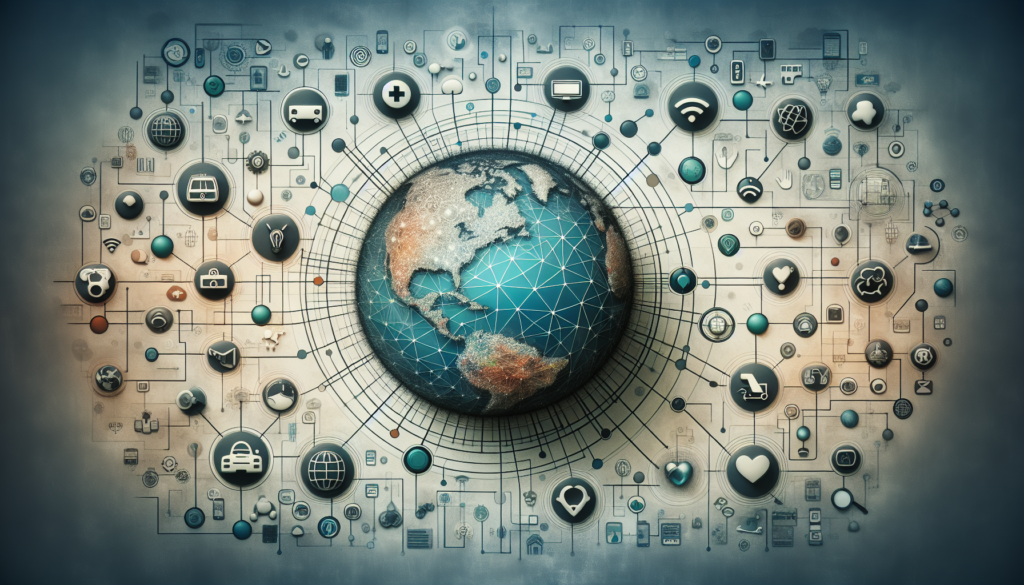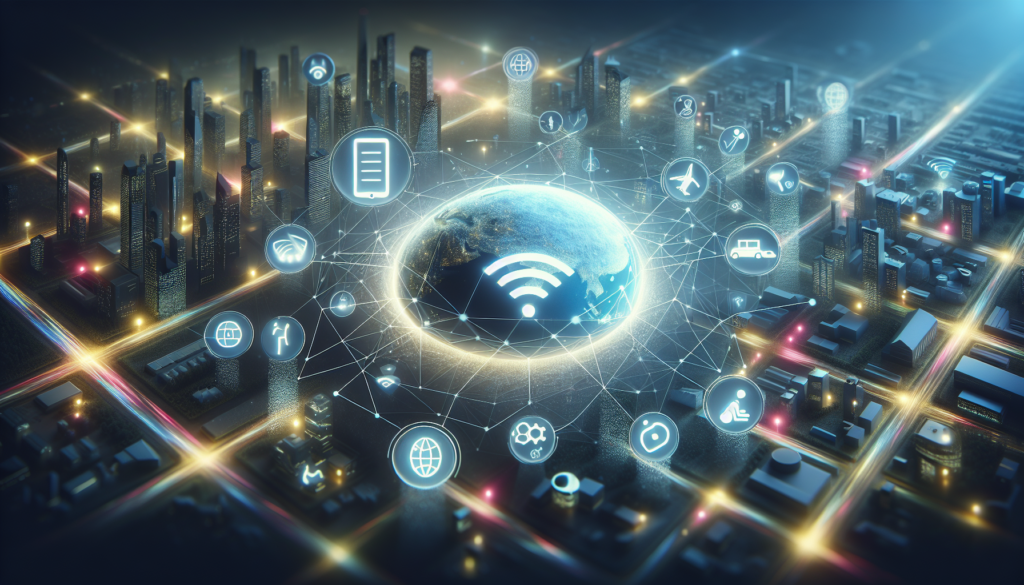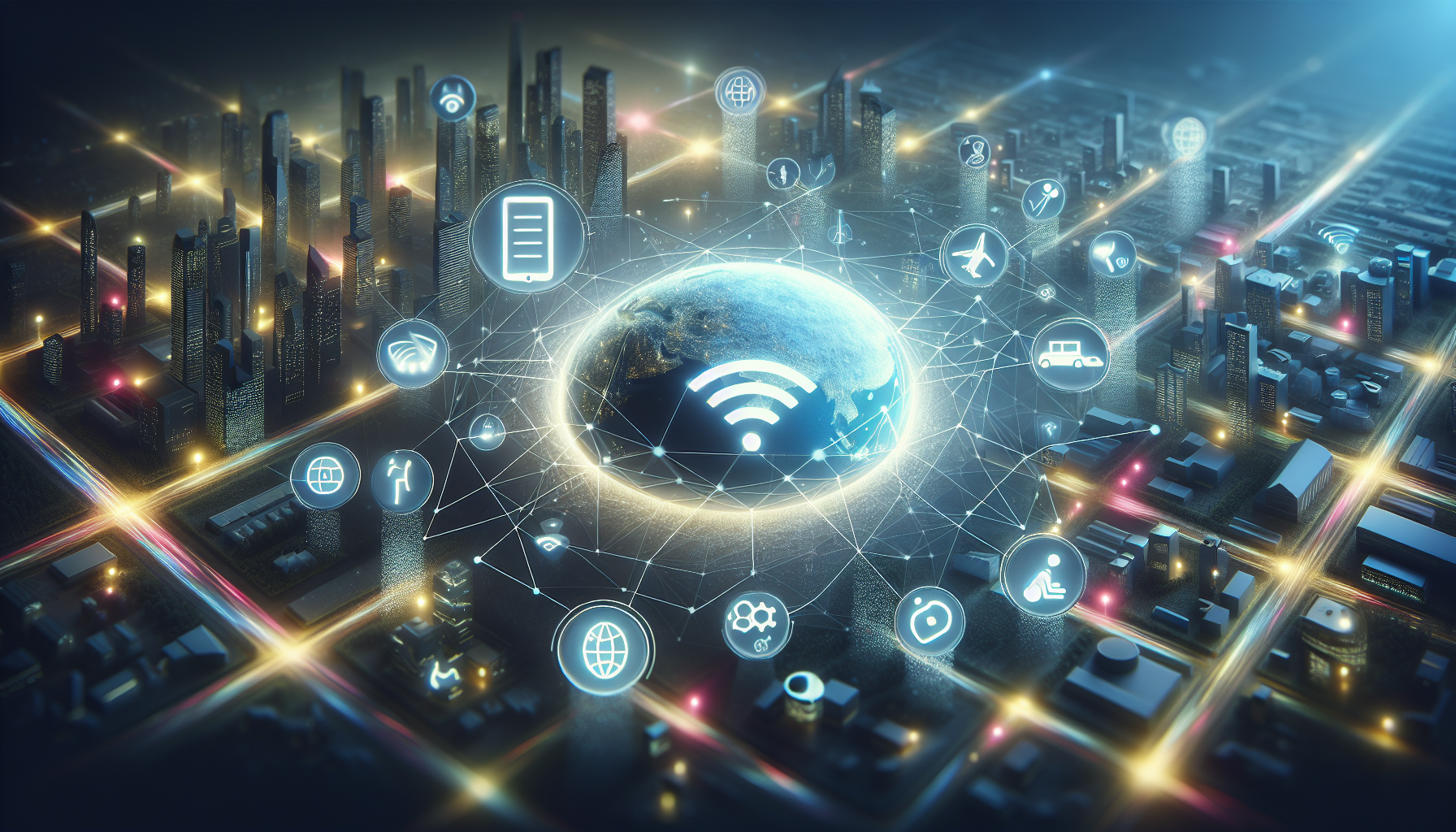IoE, short for Internet of Everything, is revolutionizing the way we live and work by connecting people, processes, data, and things through the internet. From our homes to the workplace, IoE applications can be found in various industries, including healthcare, transportation, retail, and manufacturing. Whether it’s utilizing smart devices to monitor patient health or optimizing supply chain logistics through real-time data analysis, the possibilities of IoE are endless. Discover the diverse applications of IoE and how it is transforming different sectors in this article.

Agriculture
1.1 Crop monitoring and management
In the field of agriculture, the Internet of Things (IoT) has revolutionized crop monitoring and management practices. With the help of IoT devices such as sensors and drones, farmers can now gather real-time data on soil moisture levels, temperature, humidity, and nutrient content. This data is crucial for making informed decisions regarding irrigation, fertilization, and pest control, thereby improving crop yield and reducing resource wastage. IoT-enabled crop monitoring and management systems help farmers optimize their farming practices, increase efficiency, and ultimately contribute to sustainable agriculture.
1.2 Livestock monitoring
Livestock monitoring is another area where the IoE is making significant strides. By equipping animals with IoT devices such as smart collars, ear tags, and implants, farmers can continuously monitor their health, location, and behavior. This real-time data allows farmers to detect any signs of illness, stress, or unusual behavior in their livestock. Additionally, IoT-based systems can help farmers track the grazing patterns of their animals, ensuring their optimal utilization of pasture lands. Livestock monitoring through the IoE not only improves animal welfare but also enhances productivity and reduces the risk of disease outbreaks.
1.3 Precision agriculture
Precision agriculture, an advanced farming technique that involves the use of IoT technologies, is transforming the agricultural landscape. With the help of IoT devices like GPS sensors, drones, and satellite imagery, farmers can create detailed maps of their fields, identifying variations in soil fertility, moisture content, and crop health. This data-driven approach enables farmers to tailor their farming practices, such as seed planting, fertilization, and pesticide application, according to the specific needs of each portion of their fields. By implementing precision agriculture techniques, farmers can optimize resource allocation, minimize environmental impact, and improve overall crop productivity.
Healthcare
2.1 Remote patient monitoring
IoT-based remote patient monitoring is revolutionizing healthcare by enabling healthcare providers to remotely monitor patients’ vital signs and health conditions. Through wearable devices and sensors, patients can transmit their health data in real-time to healthcare professionals. This continuous monitoring allows for early detection of any health issues or abnormalities, enhancing preventive care and reducing the need for hospitalizations. Remote patient monitoring not only improves patient outcomes but also provides greater convenience and comfort, particularly for the elderly and individuals with chronic illnesses.
2.2 Telemedicine
Telemedicine refers to the provision of healthcare services remotely, using communication technologies enabled by the IoE. With the help of video conferencing, chat platforms, and wearable devices, healthcare professionals can diagnose and treat patients without requiring in-person visits. Telemedicine eliminates geographical barriers, improves access to healthcare, and enables patients to receive timely medical advice from the comfort of their homes. Additionally, it reduces healthcare costs by minimizing unnecessary hospital visits and freeing up medical resources for more critical cases.
2.3 Wearable health trackers
Wearable health trackers, such as smartwatches and fitness bands, have become increasingly popular due to their ability to monitor various health parameters. These devices can track heart rate, sleep patterns, physical activity, and even stress levels. By collecting and analyzing this data, individuals can gain valuable insights into their overall health and make informed decisions regarding exercise, sleep, and stress management. Wearable health trackers empower individuals to take control of their well-being, leading to healthier lifestyles and proactive healthcare management.
Transportation
3.1 Connected vehicles
Connected vehicles, equipped with IoT technologies, are transforming the transportation industry. These vehicles can communicate with each other, as well as with infrastructure systems, enabling real-time exchange of information related to traffic conditions, road hazards, and weather updates. Connected vehicles enhance road safety by providing drivers with critical information and assisting in accident prevention. Moreover, they optimize traffic flow, reduce congestion, and improve fuel efficiency by suggesting alternative routes and promoting smooth traffic management.
3.2 Intelligent transportation systems
Intelligent transportation systems (ITS) leverage IoT to improve the efficiency and safety of transportation networks. With the integration of sensors, cameras, and communication technologies, ITS enables real-time monitoring and management of traffic flow, parking availability, and public transportation systems. This facilitates traffic optimization, reduces travel time, and enhances overall transportation capacity. Additionally, ITS fosters sustainability by promoting greener transportation options and reducing greenhouse gas emissions.
3.3 Fleet management
Fleet management has been greatly streamlined with the advent of IoT-enabled solutions. By equipping vehicles with sensors and GPS trackers, fleet managers can gather real-time data on fuel consumption, driver behavior, vehicle diagnostics, and maintenance schedules. This data allows for efficient allocation of resources, proactive maintenance, and improved route planning. IoT-powered fleet management systems enable companies to minimize costs, optimize fuel usage, and enhance overall operational efficiency.
Manufacturing
4.1 Industrial automation
Industrial automation, enabled by the IoE, is revolutionizing the manufacturing sector. IoT devices such as sensors, actuators, and robotics systems are integrated into manufacturing processes to enable autonomous operations and real-time analytics. Industrial automation enhances productivity, reduces errors, and improves product quality by automating repetitive tasks and optimizing resource allocation. By leveraging IoT technologies, manufacturers can achieve higher efficiency, lower costs, and increased competitiveness in the global market.
4.2 Predictive maintenance
Predictive maintenance, made possible by the IoE, helps manufacturers monitor the condition of their equipment and predict maintenance needs before failures occur. By collecting and analyzing real-time data from sensors and machine learning algorithms, manufacturers can identify patterns and anomalies that indicate potential equipment failures. This enables proactive maintenance, prevents unexpected downtime, and prolongs the lifespan of assets. Predictive maintenance reduces maintenance costs, optimizes equipment utilization, and improves overall operational reliability.
4.3 Supply chain optimization
IoT technologies play a crucial role in optimizing supply chain management. By incorporating sensors and RFID tags into products, manufacturers can track their inventory in real-time, monitor product quality, and ensure timely delivery. IoT-enabled supply chain systems provide end-to-end visibility, enabling manufacturers to streamline logistics, reduce inventory holding costs, and ensure efficient order fulfillment. Furthermore, IoT-based analytics and predictive modeling can help identify bottlenecks, optimize demand forecasting, and prevent supply chain disruptions, leading to improved customer satisfaction and reduced costs.

Energy
5.1 Smart grid management
The IoE has enabled the development of smart grid management systems, revolutionizing the energy sector. Smart grids leverage IoT technologies to monitor and control the flow of electricity, ensuring efficient energy distribution and consumption. By incorporating sensors, intelligent meters, and automation systems, smart grids enable real-time monitoring of energy demand, grid stability, and equipment performance. This enables utilities to optimize energy generation, reduce power outages, and promote renewable energy integration.
5.2 Energy consumption optimization
IoT devices are empowering individuals and businesses to optimize their energy consumption. Smart home devices, such as smart thermostats and appliance controls, enable users to monitor and control their energy usage remotely. Additionally, IoT-based energy management systems provide real-time energy consumption data, allowing users to identify energy-intensive appliances and adjust usage patterns accordingly. Energy consumption optimization not only reduces utility bills but also contributes to environmental sustainability by minimizing energy wastage and promoting energy-efficient practices.
5.3 Renewable energy integration
Renewable energy integration has been significantly enhanced by IoT technologies. By incorporating sensors and predictive analytics, renewable energy systems such as solar panels and wind turbines can be optimized for maximum efficiency and output. IoT-enabled monitoring systems provide real-time data on energy generation, storage, and distribution, allowing for better management and integration of renewable energy sources into existing grids. This enables a smoother transition towards a more sustainable and decentralized energy infrastructure.
Smart Cities
6.1 Smart infrastructure
Smart infrastructure is a key component of building smarter cities. By embedding IoT technologies into urban infrastructure systems such as buildings, roads, and utilities, cities can become more sustainable, efficient, and responsive to citizens’ needs. Smart infrastructure includes features like smart lighting, waste management systems, and intelligent parking systems. These systems leverage IoT devices and connectivity to optimize resource usage, reduce energy consumption, and enhance overall quality of life in urban areas.
6.2 Waste management
IoT-powered waste management systems are transforming the way cities handle and manage their waste. By incorporating sensors into waste bins and collection vehicles, cities can monitor waste levels in real-time, optimize collection routes, and reduce operational costs. Additionally, IoT-based systems enable the implementation of smart recycling programs and waste segregation, contributing to environmental sustainability and circular economy principles. By leveraging the IoE, cities can efficiently and effectively manage waste, reducing landfill waste and promoting recycling initiatives.
6.3 Traffic management
Traffic management is a major challenge faced by cities worldwide. IoT technologies provide innovative solutions for efficient traffic management and congestion reduction. By integrating sensors, cameras, and software applications, cities can gather real-time traffic data, monitor road conditions, and optimize traffic signal timings. This enables the implementation of intelligent traffic management systems that can dynamically respond to traffic flows, suggest alternative routes, and manage congestion hotspots. IoT-powered traffic management systems enhance mobility, reduce travel time, and improve overall road safety in urban areas.
Retail
7.1 Inventory management
IoT-powered inventory management systems have revolutionized the retail industry. By attaching sensors to products and shelves, retailers can track inventory levels in real-time, automate stock replenishment processes, and reduce stockouts. Additionally, IoT devices enable retailers to analyze customer buying patterns, optimize pricing strategies, and improve demand forecasting accuracy. IoT-based inventory management systems streamline operations, reduce costs, and ensure that products are readily available to meet customer demands.
7.2 Personalized marketing
Personalized marketing is significantly enhanced through the use of IoT technologies. By leveraging data collected from IoT devices such as smartwatches, smartphones, and beacons, retailers can gain valuable insights into customer preferences, behaviors, and location. This enables retailers to deliver targeted and personalized marketing messages, offers, and recommendations to individual customers. By tailoring marketing efforts to specific customer needs and preferences, retailers can enhance customer satisfaction, improve sales conversion rates, and build stronger customer relationships.
7.3 Customer experience enhancement
IoT technologies are playing a crucial role in enhancing the overall customer experience in the retail industry. Smart fitting rooms equipped with IoT devices enable customers to request assistance, receive personalized product recommendations, and virtually try on items. Self-checkout systems leveraging IoT technologies streamline the payment process and reduce waiting times. Additionally, IoT-powered customer service bots provide instant support and guidance, improving customer engagement and satisfaction. By integrating IoT solutions, retailers can create seamless and interactive experiences for their customers, ultimately driving customer loyalty and sales.
Education
8.1 Connected classrooms
Connected classrooms, enabled by IoT technologies, are revolutionizing the education sector. By equipping classrooms with IoT devices such as interactive whiteboards, tablets, and smart projectors, educators can create immersive and engaging learning environments. IoT-powered classroom management systems enable real-time monitoring of student progress, personalized learning experiences, and collaborative learning activities. Additionally, IoT devices can facilitate remote learning and virtual field trips, expanding educational opportunities beyond traditional classroom boundaries.
8.2 Online learning platforms
Online learning platforms leveraging IoT technologies are transforming the way education is delivered. By providing remote access to educational resources, interactive lessons, and personalized learning experiences, online learning platforms enable students to learn at their own pace and convenience. IoT devices such as laptops, smartphones, and wearable devices enhance the accessibility and flexibility of online learning. Furthermore, IoT-powered analytics and learning management systems provide educators with valuable insights into student performance and engagement, facilitating targeted interventions and personalized support.
8.3 Student performance analytics
IoT-based student performance analytics is enhancing the assessment and evaluation processes in education. By collecting data from various IoT devices, educational institutions can gather comprehensive information on student engagement, learning progress, and academic achievements. This data-driven approach enables educators to identify areas where students may need additional support or intervention. IoT-powered student performance analytics promotes personalized learning, early detection of learning gaps, and data-informed decision-making, ultimately improving educational outcomes and student success.
Home Automation
9.1 Smart thermostats
Smart thermostats are key components of home automation systems enabled by the IoE. These devices allow homeowners to remotely control and schedule their heating, ventilation, and air conditioning (HVAC) systems, optimizing energy usage and reducing utility bills. By leveraging IoT technologies, smart thermostats can learn the homeowners’ preferences and adjust temperature settings accordingly. Additionally, they provide real-time energy consumption data, helping homeowners make informed decisions regarding energy conservation and efficiency.
9.2 Security and surveillance
The IoE has revolutionized home security and surveillance systems, providing homeowners with enhanced protection and peace of mind. IoT devices such as smart cameras, doorbell cameras, and sensors enable remote monitoring of the home, real-time alerts, and video footage storage. Integrated with mobile applications, these devices allow homeowners to remotely control and access their security systems, receive notifications of any suspicious activities, and even communicate with visitors at their doorsteps. IoT-powered security and surveillance systems provide an extra layer of security and convenience for homeowners.
9.3 Lighting and appliance control
Lighting and appliance control systems enabled by the IoE are transforming the way homeowners interact with their homes. IoT devices such as smart light bulbs, outlets, and switches enable remote control and scheduling of lighting and appliances. By integrating these devices with voice assistants and mobile applications, homeowners can easily adjust lighting levels, turn appliances on or off, and create customized settings. IoT-powered lighting and appliance control systems enhance energy efficiency, convenience, and overall comfort within the home.
Environment
10.1 Air and water quality monitoring
The IoE is playing a significant role in monitoring and managing air and water quality. IoT devices such as sensors and monitoring stations can continuously measure various pollutants and water quality parameters. Real-time data on air and water quality enables authorities to detect pollution sources, monitor trends, and implement effective mitigation measures. Additionally, IoT-powered alert systems can notify the public about hazardous conditions, promoting public health and environmental awareness.
10.2 Environmental control systems
Environmental control systems, enabled by the IoE, are crucial for maintaining optimal conditions in various environments. These systems leverage IoT devices to monitor and regulate temperature, humidity, CO2 levels, and air quality in indoor and outdoor settings. For example, smart HVAC systems can dynamically adjust temperature and airflow based on real-time occupancy and ambient conditions. By optimizing environmental conditions, IoT-enabled systems enhance energy efficiency, occupant comfort, and sustainability in buildings and other enclosed spaces.
10.3 Waste management
The IoE is revolutionizing waste management practices, promoting sustainable and efficient waste disposal and recycling. IoT devices such as smart bins and waste collection vehicles facilitate real-time monitoring of waste levels, optimize waste collection routes, and enable better resource allocation. Additionally, IoT-based waste sorting and recycling systems improve the efficiency and accuracy of waste segregation processes, promoting the circular economy and reducing landfill waste. IoT-powered waste management systems contribute to environmental sustainability and promote responsible waste disposal practices.
In conclusion, the Internet of Things (IoT) has found applications in various sectors, revolutionizing industries and improving everyday life. From agriculture to healthcare, transportation to manufacturing, energy to smart cities, retail to education, and home automation to environmental management, the IoE is transforming the way we live and work. By leveraging IoT technologies, industries and individuals can enhance productivity, optimize resource usage, improve efficiency, and ultimately create a more sustainable and connected world.
